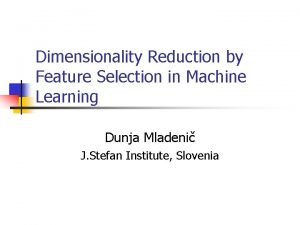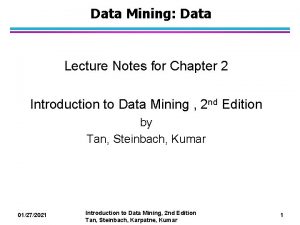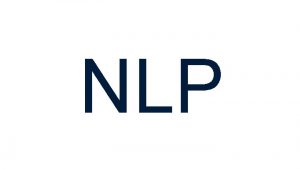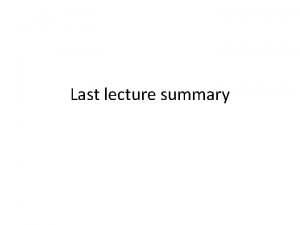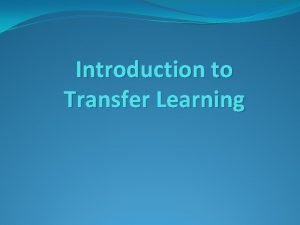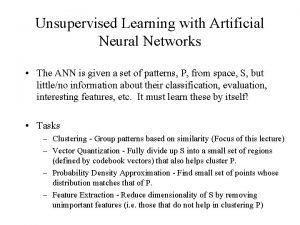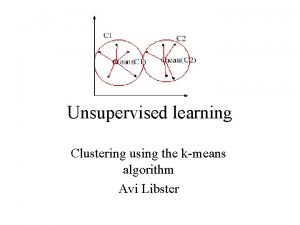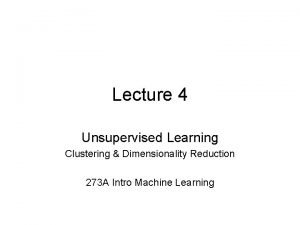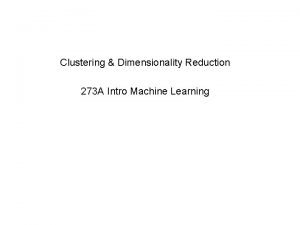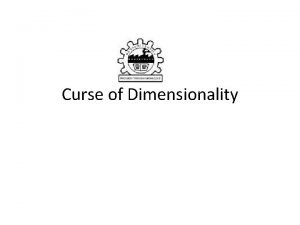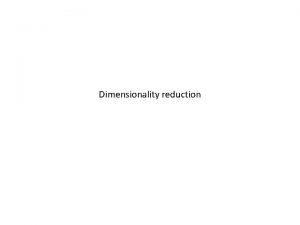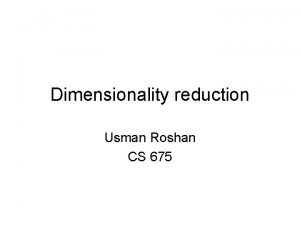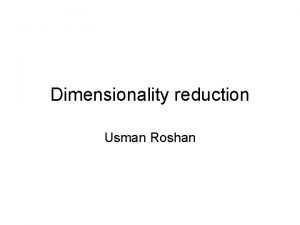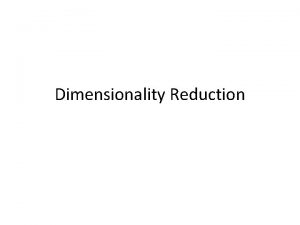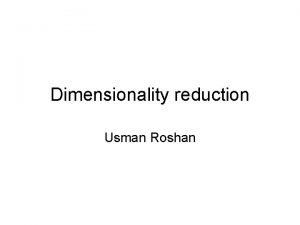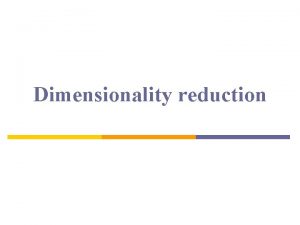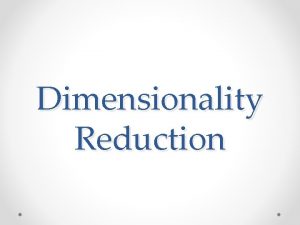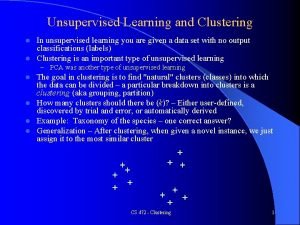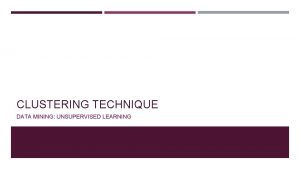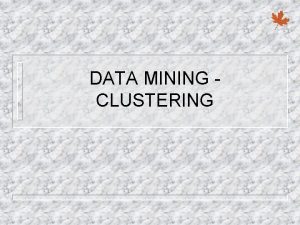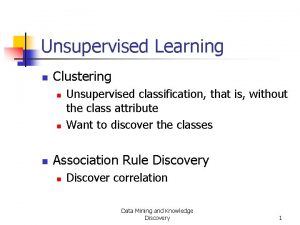Unsupervised Learning Clustering Dimensionality Reduction 273 A Intro

















- Slides: 17

Unsupervised Learning Clustering & Dimensionality Reduction 273 A Intro Machine Learning

What is Unsupervised Learning? • In supervised learning we were given attributes & targets (e. g. class labels). In unsupervised learning we are only given attributes. • Our task is to discover structure in the data. • Example I: the data may be structured in clusters: • Example II: the data may live on a lower dimensional manifold: Is this a good clustering?

Why Discover Structure ? • Data compression: If you have a good model you can encode the data more cheaply. • Example: To encode the data I have to encode the x and y position of each data-case. However, I could also encode the offset and angle of the line plus the deviations from the line. Small numbers can be encoded more cheaply than large numbers with the same precision. • This idea is the basis for model selection: The complexity of your model (e. g. the number of parameters) should be such that you can encode the data-set with the fewest number of bits (up to a certain precision).

Why Discover Structure ? the a on. . . • Often, the result of an unsupervised learning algorithm is a new representation for the same data. This new representation should be more meaningful and could be used for further processing (e. g. classification). • Example I: Clustering. The new representation is now given by the label of a cluster to which the data-point belongs. This tells us how similar data-cases are. • Example II: Dimensionality Reduction. Instead of a 100 dimensional vector of real numbers, the data are now represented by a 2 dimensional vector which can be drawn in the plane. • The new representation is smaller and hence more convenient computationally. • Example I: A text corpus has about 1 M documents. Each document is represented as a 20, 000 dimensional count vector for each word in the vocabulary. Dimensionality reduction turns this into a (say) 50 dimensional vector for each doc. However: in the new representation documents which are on the same topic, but do not necessarily share keywords have moved closer together! 5 4 7 0 0 0 1 3 5 0 0 0 1 0 0 0 4 0 0 1. . .

Clustering: K-means • We iterate two operations: 1. Update the assignment of data-cases to clusters 2. Update the location of the cluster. • Denote the assignment of data-case “i” to cluster “c”. • Denote the position of cluster “c” in a d-dimensional space. the location of data-case i • Then iterate until convergence: 1. For each data-case, compute distances to each cluster and the closest one: 2. For each cluster location, compute the mean location of all data-cases assigned to it: Nr. of data-cases in cluster c Set of data-cases assigned to cluster c

K-means • Cost function: • Each step in k-means decreases this cost function. • Often initialization is very important since there are very many local minima in C. Relatively good initialization: place cluster locations on K randomly chosen data-cases. • How to choose K? Add complexity term: Or X-validation Or Bayesian methods and minimize also over K

Vector Quantization • K-means divides the space up in a Voronoi tesselation. • Every point on a tile is summarized by the code-book vector “+”. This clearly allows for data compression !

Mixtures of Gaussians • K-means assigns each data-case to exactly 1 cluster. But what if clusters are overlapping? Maybe we are uncertain as to which cluster it really belongs. • The mixtures of Gaussians algorithm assigns data-cases to cluster with a certain probability.

Mo. G Clustering Covariance determines the shape of these contours • Idea: fit these Gaussian densities to the data, one per cluster.

EM Algorithm: E-step • “r” is the probability that data-case “i” belongs to cluster “c”. • is the a priori probability of being assigned to cluster “c”. • Note that if the Gaussian has high probability on data-case “i” (i. e. the bell-shape is on top of the data-case) then it claims high responsibility for this data-case. • The denominator is just to normalize all responsibilities to 1:

EM Algorithm: M-Step total responsibility claimed by cluster “c” expected fraction of data-cases assigned to this cluster weighted sample mean where every data-case is weighted according to the probability that it belongs to that cluster. weighted sample covariance

EM-Mo. G • EM comes from “expectation maximization”. We won’t go through the derivation. • If we are forced to decide, we should assign a data-case to the cluster which claims highest responsibility. • For a new data-case, we should compute responsibilities as in the E-step and pick the cluster with the largest responsibility. • E and M steps should be iterated until convergence (which is guaranteed). • Every step increases the following objective function (which is the total log-probability of the data under the model we are learning):

Dimensionality Reduction • Instead of organized in clusters, the data may be approximately lying on a (perhaps curved) manifold. • Most information in the data would be retained if we project the data on this low dimensional manifold. • Advantages: visualization, extracting meaning attributes, computational efficiency

Principal Components Analysis • We search for those directions in space that have the highest variance. • We then project the data onto the subspace of highest variance. • This structure is encoded in the sample co-variance of the data:

PCA • We want to find the eigenvectors and eigenvalues of this covariance: ( in matlab [U, L]=eig(C) ) 0 0 eigenvalue = variance in direction eigenvector Orthogonal, unit-length eigenvectors.

PCA properties (U eigevectors) (u orthonormal U rotation) 0 0 (rank-k approximation) (projection)

PCA properties is the optimal rank-k approximation of C in Frobenius norm. I. e. it minimizes the cost-function: Note that there are infinite solutions that minimize this norm. If A is a solution, then is also a solution. The solution provided by PCA is unique because U is orthogonal and ordered by largest eigenvalue. Solution is also nested: if I solve for a rank-k+1 approximation, I will find that the first k eigenvectors are those found by an rank-k approximation (etc. )
 K ramachandra murthy
K ramachandra murthy Dimensionality reduction in machine learning
Dimensionality reduction in machine learning K means dimensionality reduction
K means dimensionality reduction Types of attributes in data mining
Types of attributes in data mining Nlp dimensionality reduction
Nlp dimensionality reduction Unsupervised hierarchical clustering
Unsupervised hierarchical clustering Nyt top stories
Nyt top stories Partitional clustering vs hierarchical clustering
Partitional clustering vs hierarchical clustering Flat clustering vs hierarchical clustering
Flat clustering vs hierarchical clustering Lda supervised or unsupervised
Lda supervised or unsupervised Perbedaan supervised dan unsupervised classification
Perbedaan supervised dan unsupervised classification Unsupervised learning in data mining
Unsupervised learning in data mining Transductive learning for unsupervised text style transfer
Transductive learning for unsupervised text style transfer Autoencoders
Autoencoders Maxnet neural network
Maxnet neural network Is pca unsupervised learning
Is pca unsupervised learning Unsupervised learning
Unsupervised learning Andrew ng introduction to machine learning
Andrew ng introduction to machine learning

